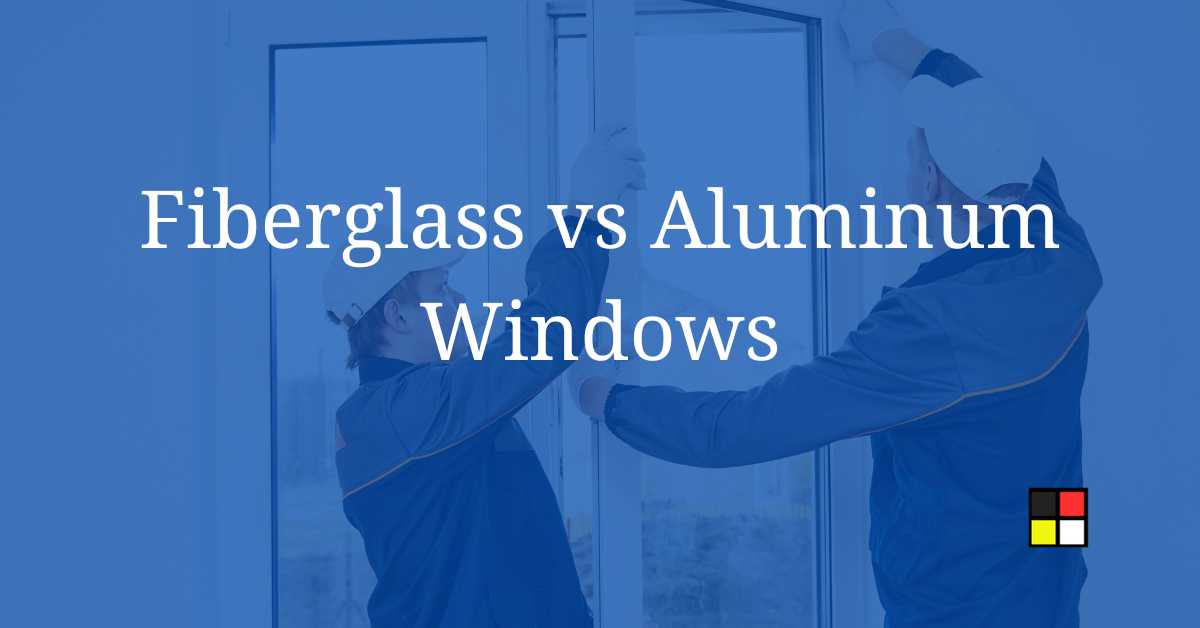When considering new windows for your home, you may be contemplating the merits of fiberglass versus aluminum options.
Both materials bring distinct advantages to the table, and your choice can affect everything from the aesthetics of your home to its energy efficiency. Fiberglass windows are known for their durability and insulation qualities.
They are capable of enduring harsh weather conditions and can last for many years with minimal maintenance. On the other hand, aluminum windows boast a high strength-to-weight ratio, are resistant to corrosion, and offer a slim profile for maximum glass area, allowing for more natural light.
Energy efficiency is another important consideration in this comparison.
Fiberglass windows have excellent insulating properties, which can help to reduce your heating and cooling costs.
Aluminum windows can also be energy efficient, especially when equipped with thermal breaks, although they typically do not insulate as well as fiberglass.
When it comes to design, both materials offer a range of options to complement your home’s aesthetic. While aluminum frames offer a modern look and can be painted in a wide array of colors, fiberglass frames mimic the appearance of painted wood without the need for frequent repainting or maintenance.
Key Takeaways
- Fiberglass and aluminum windows each have unique benefits that cater to different homeowner needs.
- Energy efficiency and durability are significant factors in deciding between fiberglass and aluminum windows.
- Design flexibility allows both fiberglass and aluminum windows to match a variety of home styles.
Material Overview
When considering the materials for your windows, it’s essential to understand the specific properties of fiberglass and aluminum, as they can significantly impact performance, durability, and aesthetics.
Properties of Fiberglass
Fiberglass windows are known for their excellent thermal performance, which makes them energy efficient; they reduce the loss of heating and cooling in your home.
Due to the material’s innate strength, fiberglass frames can be slimmer yet stronger, allowing for a larger area of glass.
This contributes to more natural light entering your home without sacrificing insulation. A notable advantage of fiberglass is its longevity; these windows can last more than 50 years.
Properties of Aluminum
In contrast, aluminum windows offer a high strength-to-weight ratio, which means they can support large panes of glass with slender frames, resulting in a modern aesthetic with a sleek design. They are also less susceptible to environmental damage such as warping or rotting.
Aluminum frame systems can potentially help you achieve higher LEED certifications for your building, a testament to their favorability in sustainable building designs. However, they can conduct heat, potentially affecting thermal efficiency unless they include a thermal break.
Durability & Maintenance
When you’re deciding between fiberglass and aluminum windows, understanding their life span and the effort needed to maintain them is critical.
Fiberglass Durability & Maintenance
Fiberglass windows are known for high durability and can last more than 50 years. They resist warping, corroding, and fading, making them suitable for extreme temperatures and harsh weather conditions.
Maintenance is minimal; occasional cleaning is typically all that’s needed to keep them in pristine condition.
However, if the paint wears, a reapplication may be necessary to maintain the appearance, which is less frequent than with other materials.
- Lifespan: 50+ years
- Maintenance: Low – periodic cleaning and rare painting
For detailed insights, consider visiting gb&d magazine and Spahn & Rose for expanding your understanding of the durability and maintenance of fiberglass windows.
Aluminum Durability & Maintenance
Aluminum windows, while not as durable as fiberglass, are still a strong choice. They typically have a lifespan of around 30 years. They are less likely to crack or warp but may be prone to corrosion if not properly maintained, especially in coastal areas with salty air.
Aluminum frames require regular maintenance, such as lubricating moving parts and occasionally cleaning the frames to remove dirt and debris. Some may also require repainting over time to treat cosmetic damage or to restore weather resistance.
- Lifespan: About 30 years
- Maintenance: Moderate – frequent cleaning, lubrication, and potential repainting
To delve further, references such as Brennan Corporation’s blog outline more specifics on aluminum window durability and how they contribute to LEED certifications.
Energy Efficiency & Insulation
When considering new windows for your home, energy efficiency is paramount. Both the insulation performance of fiberglass and aluminum windows directly impacts your energy consumption and costs.
Fiberglass Insulation Performance
Fiberglass windows boast excellent insulation due to their composition, which inhibits thermal transfer. This energy efficiency is achieved through the material’s low thermal conductivity, meaning your home stays warmer in winter and cooler in summer without overworking your heating or cooling systems.
Aluminum Insulation Performance
Conversely, aluminum windows have higher thermal conductivity, which can lead to increased energy loss. However, modern aluminum windows typically include a thermal break, a barrier that reduces heat loss.
Implementing such a feature can help aluminum frames achieve LEED certifications, although they may still lag behind fiberglass in overall insulation performance.
Aesthetics & Design Flexibility
When considering aesthetics and design flexibility for your windows, you want to ensure that your choice enhances your home’s appearance while also offering the adaptability to fit your architectural style.
Fiberglass Aesthetics
Fiberglass windows provide a wide array of style options. You can choose from various colors and finishes, which allow for a highly customizable look that can complement your home’s design.
Fiberglass also can mimic the natural look of wood, giving you a classic appearance without the maintenance drawbacks.
Aluminum Aesthetics
Aluminum windows offer a different kind of aesthetic, known for their sleek and modern appearance. The frames are often slimmer, which maximizes glass area for unobstructed views and ample natural light.
This material’s malleability also means it can be configured into a multitude of shapes, catering to the specific design needs of your home.
Cost Considerations
In choosing between aluminum and fiberglass windows, your focus on cost will need to take into account both the initial purchase price and the long-term financial impact.
Initial Cost Comparison
As you first purchase windows, aluminum options tend to be less expensive than fiberglass. Fiberglass windows may cost more upfront, with prices influenced by their durability and energy efficiency features.
When compared to vinyl, fiberglass windows are approximately 12-15% more expensive, yet still cost less than aluminum by about 40%.
Long-Term Value
The long-term value of windows is measured by their lifespan, maintenance needs, and energy efficiency. Fiberglass windows can last over 50 years, withstand extreme temperatures, and provide considerable energy savings due to their insulative properties.
In contrast, while aluminum windows can help achieve LEED certifications for sustainable building, they are less insulating than fiberglass and might contribute to higher heating and cooling costs over time.
Installation & Customization
When choosing between fiberglass and aluminum windows, the nuances of installation and customization play a pivotal role in your decision-making process.
Fiberglass Installation
Fiberglass windows offer a mix of durability and adaptability. They can be molded into various shapes and styles, fitting your specific design preferences. With a material that’s less prone to expansion and contraction, fiberglass windows maintain their integrity in a range of temperatures. Installers may find the process straightforward, but precision is key to ensure proper fit and finish.
Aluminum Installation
Aluminum windows, noted for their slim profiles, allow for maximized glass area and can contribute to achieving high levels of daylighting in your space.
These frames are generally lightweight, which can simplify the handling and installation process. However, care must be taken to ensure appropriate thermal barriers are in place, as aluminum conducts heat and cold more readily.
Frequently Asked Questions
When choosing between fiberglass and aluminum windows, you are looking at factors like durability, cost, energy efficiency, and maintenance. Understanding these aspects will help you make an informed decision for your home.
What are the advantages and disadvantages of fiberglass and aluminum windows?
Fiberglass windows are praised for their durability and energy efficiency, often lasting more than 50 years and offering excellent insulation. They resist temperature extremes well but tend to be more expensive and less available.
On the other hand, aluminum windows are known for their strength, sleek design, and lower upfront costs. However, they are less energy-efficient due to their high thermal conductivity and might not be the best for extreme climates.
How do fiberglass windows compare in price with aluminum windows?
Price comparisons show that fiberglass windows can be about 25 percent more expensive than vinyl, and roughly half the cost of aluminum-clad wood. While aluminum windows might be cheaper initially, fiberglass can offer better long-term value due to its energy-saving properties.
What are the typical lifespans of fiberglass windows versus aluminum windows?
Fiberglass windows can have an impressive lifespan, often exceeding 50 years due to their ability to withstand severe weather conditions without corroding or warping. Aluminum windows, while also durable, may not last as long, especially in coastal areas where the salt air can accelerate corrosion.
In terms of energy efficiency, how do fiberglass and aluminum windows differ?
Fiberglass windows tend to be more energy-efficient than aluminum windows because fiberglass has a lower thermal conductivity, which helps to maintain a consistent temperature in your home. This can result in lower heating and cooling costs.
Aluminum conducts heat and cold more readily and might lead to greater energy loss.
How do aluminum clad wood windows differ from pure fiberglass and aluminum windows?
Aluminum-clad wood windows combine a wooden interior frame with an exterior aluminum cladding for added durability and weather protection.
These windows offer the temperature-insulating qualities of wood with the low maintenance of aluminum. However, they are usually in a different price category compared with pure fiberglass and aluminum windows.
What are the common criticisms of fiberglass windows in the industry?
Some of the criticisms of fiberglass windows include their higher cost in comparison to other materials, and their less widespread availability can be a disadvantage for some buyers. Others point out that despite their strength, the design options may be limited when compared to aluminum or wood windows.






